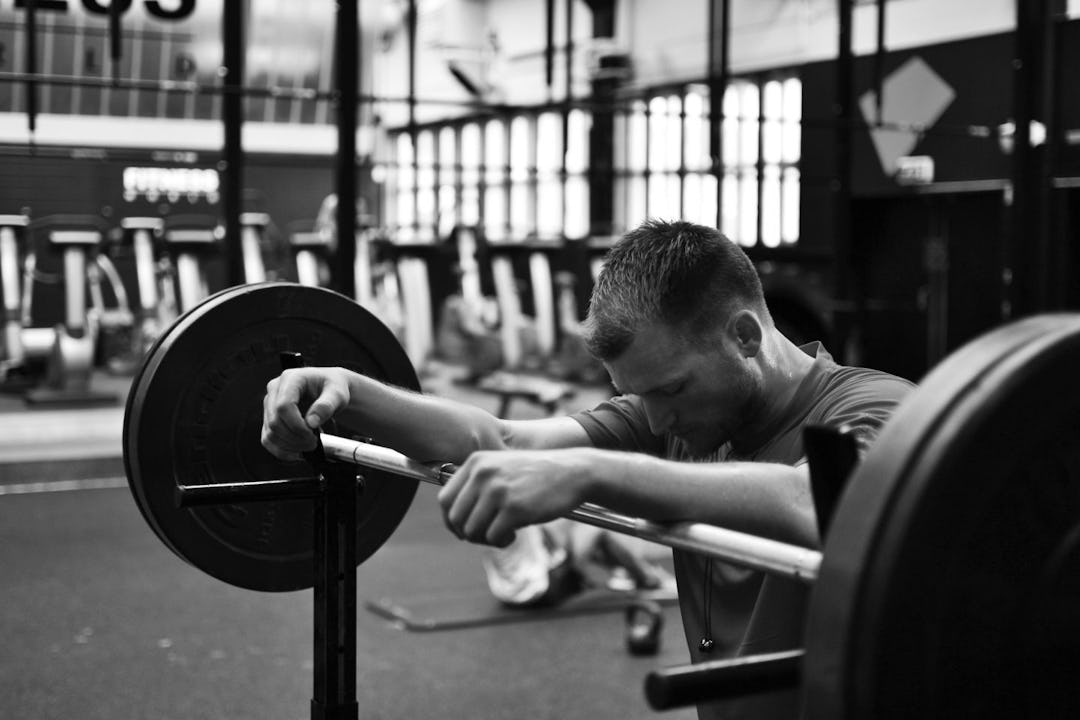
Think about how you train pullups. You jump up to the bar and grind out as many as you can, right? Rest until you think you can get the same number of reps again (or close to it), and repeat. You probably do the same thing for pushups and dips.
Regardless of the exercise, let’s say you do three sets, getting 10 reps the first set, 8 the second, and 7 the third, and you rest about two minutes between sets. Altogether, that’s 25 total reps and six minutes of rest time.
Now what if there was a way to do more total reps in less time? Your workout would be more efficient, and you’d deliver a bigger growth stimulus to your muscles. How might that be done?
Here’s one way, called a waving ladder. Do 7 reps, then 1 rep, then 6, 2, 5, 3, and 4 reps, resting 30 seconds between sets. Add it all up and you’ve done 28 total reps with just three and a half minutes of rest. Compare that to your normal routine—it’s 12% more volume and 40% less time spent resting!
By holding back and doing fewer reps than you’re capable of each set, you can actually do more work overall, get out of the gym faster, and have it feel almost easy to boot.
The ladder method is the ultimate hack for muscle and strength. It helps you smash plateaus, speed up your workouts, and it doesn’t just work on bodyweight exercises—it can blow up your deadlift, squat, and bench press numbers too, as well as your kettlebell lifts. You’re about to learn how using ladders can make setting PR’s feel (almost) effortless.
The Ladder Method: The Easiest Way To Get Big and Strong
What Is The Ladder Method?
Ladders were developed by strength coaches in the Soviet Union, and were a secret weapon in the training of Eastern Bloc athletes—guys and gals who dominated strength and power sports in the Olympics for decades. They’re a time-tested trick for getting big and strong fast, and they’re not hard to do.
I first learned about ladders from strength coach Pavel Tsatsouline, an expert on old Soviet sports training methods. He taught me that a traditional ladder is a series of sets of ascending reps with a constant load. For example, you do one pullup, rest, then two pullups, rest, three pullups, and so on until you hit a goal number for the workout. Climbing, shall we say, from 1 to 10 reps, is one ladder. The second ladder starts over at one rep and works back up to 10 reps, or 8, or 6, or whatever suits your time and energy.
The whole point is to end up doing more work on an exercise than you’d normally be capable of. Instead of maxing out every set and burning out quickly, you leave a little in your tank and, subsequently, you’re able to get more total reps. Greater volume means greater overload for your muscles, and ultimately greater gains.

The 4 Rules of Ladder Workouts
Ladders can be done several different ways, but there are four guiding principles you need to follow.
1. The most fatiguing sets (high numbers, like 9 or 10 reps) must be followed by the longest rest periods. This is one reason that ladders are great to do with a partner. Old-school gym rats call it the “I go, you go” approach because you can gauge rest periods by how long it takes your partner to do his/her set. You rest while he does his reps, and vice versa. It takes longer for a partner to perform 10 reps than it does 1 or 2, so working out with someone else usually builds appropriate rests into your workout automatically.
If you’re by yourself, remember not to rush to the next set, or you won’t be able to complete the ladder. A good rule of thumb for solo lifters is to match the number of deep breaths you take with the number of reps you just performed. For example, after a set of three reps, you’ll take three slow, deep breaths before the next set; after a set of 10 reps you’ll take 10 breaths, and so on. Nevertheless, if you feel you need more rest to get the number of reps you need next, take it. The higher the reps in your ladder, or the heavier the weights you’re using, the more rest you’ll need.
2. The most fatiguing set (again, the one with the most reps) is followed by the least fatiguing one (the lowest number of reps). After doing a set of 10 on an ascending or waving ladder, for instance, you’ll start over at 1 rep. Note that the one exception is a descending ladder, which is explained below.
3. No set is ever taken to failure. Every rep should be done with perfect form and performed explosively. For this reason, choose ladders with conservative rep ranges that you know you can perform properly. If 10 reps is your max on pullups, your ladder should only go as high as 7 or 8 reps.
4. Limit your ladders to 2–4 per workout. Doing more work than that can lead to overtraining, and it increases the chance that your form will break down.

Types of Ladder Workouts
I started programming ascending ladders (the number of reps goes up each set) of 1–10 reps for some MMA fighters I was training. For variety, I would sometimes reverse the order and have them do a descending ladder—starting with 10 reps and working down to 1, 3, or 5. I like the descending ladder because most of the work (the higher-rep sets) is done early in the workout when the athlete is less fatigued, leading to better technique on all the sets, but either approach will allow you to perform a lot of volume in minimal time. Experiment with both and see which one you like best.
The one potential problem with these two types of ladders is that the hardest sets are done in sequence. For example, you do 8 reps, 9 reps, and then 10 reps, or the other way around, if it’s a descending ladder. For some people, that just creates too much fatigue for them to make it through the whole ladder without using sloppy form or going to failure. To fix the problem, I started using waving ladders like the one I showed in the introduction. Alternating high and low reps really minimizes the buildup of fatigue, and it helps potentiate the nervous system to improve muscle strength.
To do a waving ladder, you switch back and forth between the highest and lowest reps in your ladder and meet in the middle. For ladders of 1–10 reps, your sets would go: 1, 10, 2, 9, 3, 8, 4, 7, 5, 6, or, if you wanted to do them descending style, 10, 1, 9, 2, 8, 3, 7, 4, 6, 5.

Ladder Workout Routines For Fat Loss
I often use ladders to make full-body workouts for busy clients who want to lean down. A good total-body session need only consist of three exercises—an upper-body pulling movement, an upper-body pushing movement, and a lower-body exercise. For example, a pullup, dip, and kettlebell swing. I’ll create a circuit with these exercises, using both waving ascending and descending ladders. See the table below for an example.
Sample Ladder Circuit Workout
![]()
Because fatigue is so well managed by the changing number of reps, you won’t need much rest between sets. Again, take the number of deep breaths that matches the number of reps you just performed (10 swings are followed by 10 deep breaths, etc.) Even though you’ll be performing a whopping 30 total sets (10 per exercise), you can fly through this workout in under 20 minutes.

Ladder Workouts For Strength
Ladders work especially well for getting strong on the classic barbell exercises, and highly technical lifts such as the kettlebell windmill and one-arm snatch. But in this case, you’ll want to use much lower reps and do fewer total sets than you do for bodyweight exercises. One effective programming strategy is to perform a ladder of 1 to 3 reps with the heaviest weight you can handle for 5 perfect reps (your five repetition-maximum, or 5RM). You can do this with ascending, descending, or waving ladders, as follows.
Load: 5RM
Two ascending ladders: 6 total sets. Reps of 1, 2, 3, 1, 2, 3
Two descending ladders: 6 total sets. Reps of 3, 2, 1, 3, 2, 1
Two waving ladders: 6 total sets. Reps of 3, 1, 2, 3, 1, 2
You’re welcome to skip a “rung” or two on an ascending or descending ladder as well, jumping by more than one rep at a time. A good strength ladder can be done with sets of 1, 3, and 5 reps. Understand, however, that using a broader rep range will build up more fatigue, so you’ll have to compensate by using less weight. Doing ladders with a load that allows you seven reps (a 7RM) offers a good blend of strength and muscle gain with a slightly lower risk of injury.
Load: 7RM
Two ascending ladders: 6 total sets. Reps of 1, 3, 5, 1, 3, 5
Two descending ladders: 6 total sets. Reps of 5, 3, 1, 5, 3, 1
Two waving ladders: 6 total sets. Reps of 5, 1, 3, 5, 1, 3
As with all heavy lifting, your rest between sets should be generous—much longer than when doing bodyweight exercises. Don’t attempt five reps of deadlifts after only a few deep breaths. In this case, rest as needed so you’re fresh for the next set, and you may need to rest even longer between ladders. With that said, because no set is very fatiguing by itself, you won’t need as much rest between sets as you would doing conventional sets to failure.
Up till now, I’ve given examples showing two ladders, but the number of ladders you perform can vary, especially if you’re going to use them in more than one workout in a week. In most cases, you’ll perform anywhere from two to four ladders in one session when training for maximal strength. If you want to bring up a weak lift fast, you can perform a second ladder workout in the week. A sample two-week schedule that repeats over the course of four to six weeks could look like this:

For instance, if you want to boost your squat, you could do three ladders of 1, 2, and 3 reps on Tuesday, and then four ladders of 5, 3, and 1 rep on Friday. The next week, you might do two ladders of 3, 1, and 2 reps Tuesday, and two ladders of 5, 1, and 3 reps on Friday.

Ladder Workouts for Muscle Growth
To maximize muscle mass with the ladder method, simply raise the number of reps you do to accrue even more training volume. With higher-rep ladders, you need to be extra conservative with the loads you choose. The weight you use should be four or more reps higher than the highest number of reps in the ladder. So if you’re going to do bench press ladders ranging from 2 to 10 reps, use a weight that you know you can handle for at least 14.
Load: 14RM
Two ascending ladders: 6 total sets. Reps of 2, 6, 10, 2, 6, 10
Two descending ladders: 6 total sets. Reps of 10, 6, 2, 10, 6, 2
Two waving ladders: 6 total sets. Reps of 10, 2, 6, 10, 2, 6
Note that you can certainly go higher than 10 reps, if your strength levels allow for it, and it’s appropriate for the exercise.
The Ladder Method Vs. Cluster Training
Similar to the ladder method, cluster training is a strategy that allows you to lift heavy weights for more total reps than you’re used to. You might take a 5RM load and perform 5 sets of 2 reps (called “clusters”) with short rest periods in between, accruing 10 total reps. Unlike with ladders, the number of reps doesn’t vary per set, and they’re always low (1–5), allowing for the heaviest possible loads.
Cluster training works great for strength, but it’s much more taxing on the central nervous system, and therefore should be used more sparingly than ladders to avoid burnout. And because ladder training provides more variability in the reps, it has the potential to produce better muscle size and endurance gains.

Customizing The Ladder Method
You can choose the type and number of ladders you do based on how you’re feeling on any given day. Work up to as many reps as you feel comfortable doing that day, and let that be the top rung of your ladder. One day when you’re feeling sluggish, you might prefer an ascending ladder on kettlebell swings that uses 2, 4, 6, 8, and 10 reps. Another day, you might feel strong and choose a waving ladder that starts with 12 or 14 reps. The key is to listen to your body and use the approach that’s right for you on that day.
I used ladders to work up to doing more than 150 pullups every day for two months as a personal challenge. Many days were a struggle, but auto-regulating the ladders made the journey possible. I never had to worry about doing a specific number of reps for any set. Instead, I would do as many reps as I felt capable of at various times throughout the day, and gradually worked my way to 150 total. You better believe my lats grew, and my whole body got stronger.
For more of Chad’s training techniques, visit chadwaterbury.com, and follow him on Instagram, @drchadwaterbury.



)





